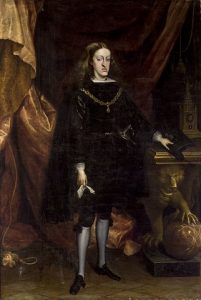 The picture you see at the top of the page is the magnificent memorial to the Surrender of Breda in 1635 painted by Velazquez. The scene and the painting marked the slow end to the almost eighty-year war of Dutch Independence. This treaty was the beginning of peace and the final acceptance by Catholic Europe that the Protestant Dutch were going to have their own country and there was no point in fighting any longer. The southern provinces (Flanders, Brabant) would remain Roman Catholic, the northern provinces would become the new Protestant United Provinces (Holland etc). Thus began a relatively peaceful later 17th century. Holland prospered. Amsterdam exploded into phenomenal growth and prosperity. But as Europe looked toward 1700, all political leaders worried about the Spanish Royal family and the fragile health of King Charles II (portrait at left). Charles had no heirs and there was no likelihood that any wold appear. Charles was sick and wasting away. The death of the King of Spain with no legitimate heir meant that the Spanish throne would pass to other heirs in either France (unacceptable to England and Holland) or Vienna (the German branch of the Habsburgs). Either choice would inevitably spark a war. And so as 1700 approached, all of the European governments watched the health reports on King Charles II in Madrid. On November 1, 1700, King Charles II of Spain died.
The picture you see at the top of the page is the magnificent memorial to the Surrender of Breda in 1635 painted by Velazquez. The scene and the painting marked the slow end to the almost eighty-year war of Dutch Independence. This treaty was the beginning of peace and the final acceptance by Catholic Europe that the Protestant Dutch were going to have their own country and there was no point in fighting any longer. The southern provinces (Flanders, Brabant) would remain Roman Catholic, the northern provinces would become the new Protestant United Provinces (Holland etc). Thus began a relatively peaceful later 17th century. Holland prospered. Amsterdam exploded into phenomenal growth and prosperity. But as Europe looked toward 1700, all political leaders worried about the Spanish Royal family and the fragile health of King Charles II (portrait at left). Charles had no heirs and there was no likelihood that any wold appear. Charles was sick and wasting away. The death of the King of Spain with no legitimate heir meant that the Spanish throne would pass to other heirs in either France (unacceptable to England and Holland) or Vienna (the German branch of the Habsburgs). Either choice would inevitably spark a war. And so as 1700 approached, all of the European governments watched the health reports on King Charles II in Madrid. On November 1, 1700, King Charles II of Spain died.

Christopher Duggan,
A Concise History of Italy,
Cambridge University Press; 2 edition (January 20, 2014),
ISBN 0521747430